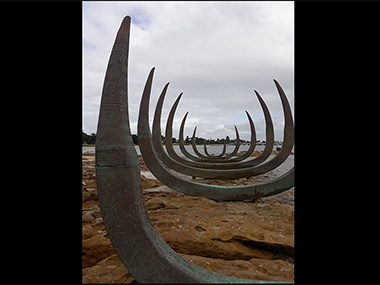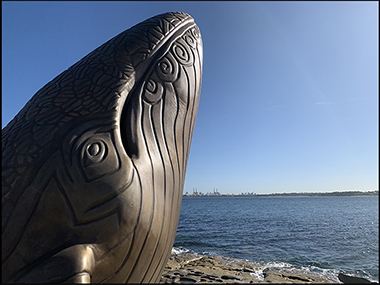COOKED 2

Alison Page's conflation of a ship's ribs with those of a beached whale at Cook's Landing Place in Kamay, Botany Bay
Posted by Jeremy Eccles | 18.05.20
I celebrated the Cook 250th earlier on this site with a delicately balanced piece attempting to find a line between those that see him as a founding father of contemporary Australia and those who see only the man who claimed an empty continent for Britain and inevitably lead to the nonsensical Terra Nullius claim that Mabo and Wik court cases have now washed away.
I also hinted at the incompetence of the 250th anniversary commemorations, with NSW making a 2005 announcement of “The development of Botany Bay as a site of reconciliation is set to continue and has endorsed and committed funds to a project to turn Captain Cook's Landing Place into a site celebrating the 'meeting of cultures'”.
Meanwhile, the Federal Government has touted this year's waste of resources on a spurious circumnavigation of Australia, which Cook never did – and it's now been cancelled.
Finally, the Kamay 2020m Project Board chaired by former MP Bruce Baird has said it will “deliver the Kamay Botany Bay National Park Master Plan, including commemorative installations, a new visitor centre, cafe and exhibition space, ferry wharves to re-establish the physical, social and cultural link between La Perouse and Kurnell, enhanced access around the site, restoration and repair of the historic Alpha House and conservation works to the 19th century Cook and other monuments”. Some $50million seems to be involved.
All a bit late, you'd think.
However, almost unreported, three commemorative bronze sculptures designed by Aboriginal artists have been installed there, just in time. A smoking ceremony was held on 20 April and they look forward to being able to hold an official welcoming event in the future once all of the community can attend.
'The Eyes of the Land and the Sea' was created by Walbanga and Wadi Wadi woman Alison Page, working with her partner Nik Lachacjzak and UAP Australia. Page explained that the work “brings together different perspectives on our shared history - the bones of the Gweagal totem of a whale and the ribs of a ship - and sits in the tidal zone between the ship and the shore where the identity of modern Australia lies. The first encounter between James Cook and the First Australians was a meeting of two very different knowledge systems, beliefs and cultures”.
'Wi-Yanga and Gurung The Whales’ and ‘Nuwi/Canoes’ were created by local Dharawal artists Theresa Ardler and Julie Squires with ThinkOTS. Ardler describes the whale as, “the dreaming figure for the Dharawal speaking people and an integral part of our community and beliefs. My Gweagal Clan looked out for whales from the Kurnell Peninsula”. The whale mother and calf were formed with intricate engravings, a tribute perhaps to Dennis Nona's works in this style, but also based on the La Perouse rock engravings of a mother humpback whale and her baby.
The purpose of the sculptures is to promote understanding and reflection on the different perspectives that people have of the events of 1770. “We want all Australians to visit this culturally significant site, to help to interpret the many stories of this historic place and, more importantly, to understand its part in our shared story,” Federal Environment Minister, Susan Ley said as she announced 50/50 funding from her Government and the State.
In a rare statement from Paul Fletcher as Minister for the Arts, he noted, “Art is a powerful tool for telling people’s stories and interpreting historical events, and we want these sculptures to promote understanding and reflection as people look back on the landing in 1770”.
The NSW National Parks and Wildlife Service is managing this project and will provide updates on the design and construction of the sculptures at the NSW National Parks and Wildlife Service website.
Oddly, there's still opportunity to contribute to this much-delayed project. NPWS say, “We would like to talk to people in the community who have a connection to Kurnell and Kamay Botany Bay National Park. The stories we collect will help guide and inform the refreshed interpretation to be installed later in the year. Contact the project team via email and we’ll be in touch. kamay.2020@environment.nsw.gov.au Submissions close on 24th May 2020
Meanwhile, I can't help but noting that we're lucky not to have a giant bottle at Botany Bay! It's what the birthplace of Cpt Cook, Middlesborough in northern England seems to enjoy.
And it was created by the rather famous American artist, Claes Oldenburg collaborating with his wife, Coosje van Bruggen.
Their website explains: “In 1986 we made our first visit to northeastern England, and were asked to participate by creating a sculpture for Middlesbrough, once a legendary centre of steel fabrication and the sculpture would be built in Hebburn, helping to provide employment for workers in the abandoned shipyards along the River Tyne.
“We felt that a nautical subject might not be inappropriate, especially since the famous explorer Captain Cook was born in the area. After investigation, we settled on a bottle, an object that could function both on land and in water, and is frequently seen washed up on the beaches of the North Sea. A recollection of Edgar Allan Poe's short story 'MS. Found in a Bottle' -- an account of a sailor trapped in a maelstrom -- suggested the element of writing. We realised that the bottle could be made of the writing itself, which would entail the type of fabrication in steel done in the yards and therefore reflect the history of Middlesbrough”.
Coosje selected as the text for the 'Bottle of Notes' an excerpt from Cook's Journals describing an astronomer's observation aboard the ship: "We had every advantage we could desire in Observing the whole of the passage of the Planet Venus over the Sun's disk”. Written out in Oldenburg's broad, angular hand in offwhite, this text formed the exterior of the bottle.
As his UK Serpentine Gallery justifies, “By shifting the scale from the small to the monumental, Oldenburg reveals the architectural potencies hidden beneath the apparent banality of objects and conjures up a vision of the marvellous in everyday reality”.
Share this:
»  del.icio.us
»
del.icio.us
»  Digg it
»
Digg it
»  reddit
»
reddit
»  Google
»
Google
»  StumbleUpon
»
StumbleUpon
»  Technorati
»
Technorati
»  Facebook
Facebook
Contact Details

The engraved whale that forms part of 'Wi-Yanga and Gurung The Whales’ by Dhar awal artists Theresa Ardler and Julie Squires

Further Research
Artists: Alison Page | Dennis Nona | Julie Squires | Theresa Ardler
News Tags: Botany Bay | Captain Cook anniversary | Claes Oldenburg | Jeremy Eccles | Kamay | Kernell | NPWS
News Categories: Blog | Event | Feature | Industry | News | Other Event
Exhibition Archive
- 28.04.21 | CANBERRA
- 23.04.21 | Sydney Biennale - 'From a Brook to a River'
- 22.04.21 | 2021 Telstra NATSIAA Finalists Announced
- 29.03.21 | THE NATIONAL 2021
- 24.03.21 | All Revealed in Freo
- 22.03.21 | Bla Mela Kantri
- 19.03.21 | Two Big Moves
- 16.03.21 | The Very Late Charlie Flannigan
- 08.03.21 | PAPUNYA ART AT 50
- 19.02.21 | National Endowment for Indigenous Visual Arts
- 11.01.21 | "Lost in Another Person's Culture”
- 04.01.21 | Appreciating Mparntwe
- 09.12.20 | Museological Sydney
- 02.12.20 | Getting Back into the Habit in Sydney
- 25.11.20 | VICTORIA OPENS!
Advertising

